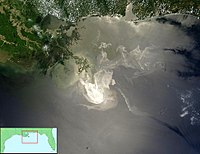
Photo from wikipedia
Abstract We report the geophysical characterisation of natural oil seep sites through a combination of sea surface evidence of oil leakage from spatial imagery with a large collection of seafloor… Click to show full abstract
Abstract We report the geophysical characterisation of natural oil seep sites through a combination of sea surface evidence of oil leakage from spatial imagery with a large collection of seafloor and subsurface geophysical data. This paper provides a detailed characterisation of one selected active seep site and identifies possible specific feature of oil seep sites. The oil seep is a complex-shaped feature on the seafloor consisting of a cluster of heterometric pockmarks inside a main depression area and peripheral metre-scale seafloor mounds. A strong deformation related to salt tectonics controls the location of the seafloor source by fracturing the overburden. The associated thermal anomaly induces a vertical modification position of the base of the gas hydrate stability zone (BGHSZ) that is used as a fluid migration route towards the crest of the diapir. The combination of local depressions and seafloor amplitude anomalies linked with vertical high-amplitude pipes rooted on the BGHSZ suggests a focused fluid flow towards the seafloor. In peripheral areas, the seafloor mounds are linked by shallow faults to buried high amplitude patches on sub-bottom profiler sections. The combination of restricted-size seafloor mounds with a progressive deepening of the high amplitude from the seafloor suggests a substantial decrease of the hydrocarbon flow towards peripheral areas. The proximity of actively oil-supplying seafloor depressions and seafloor mounds shows that the hydrocarbon flow rapidly decreases laterally. The thermogenic seep site is affected by two consistent and sub-parallel reflections with negative polarity. The first is interpreted as the methane-related BGHSZ, the second could correspond to the base of a thermogenic BGHSZ produced by a mixture of heavier gas. The seafloor roughness and double BSR appear to be specific features of oil seep sites. The geophysical features revealed at a localised study area will be extrapolated towards a larger province for relevance validation.
Journal Title: Marine and Petroleum Geology
Year Published: 2019
Link to full text (if available)
Share on Social Media: Sign Up to like & get
recommendations!